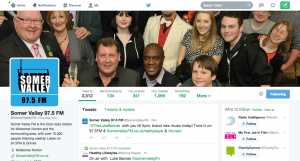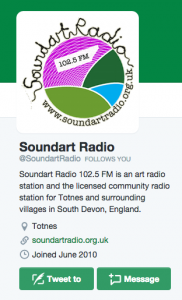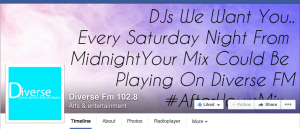Setting up successful social media profiles
The following are some things that you need to think about to present your station in the best possible light on social media:
- Having a clear description of your organisation
- Use of logos, photographs & images
- Frequency of posts
- Building your own presence / identity / voice
- Plan ahead
Making clear organisational profiles
It seems a no-brainer, but you should always have a clear description of what your organisation is/does on every profile page – usually in the bio section. Try to mention what you do that is beneficial – e.g. ‘giving young people a voice in …’. This bio section should also include clear link(s) to the station’s website. You should try to be as consistent as possible across different sites and profiles. The same goes for logos, banner images, and such (though not necessarily the images you post to your social media feeds).
Logos, photographs & images
As above, you should prominently include the station’s logo (ideally the same logo!) across your different sites and profiles. If you do need to modify the logo to fit the constraints of a particular site (e.g. making a rectangular logo fit better into a square profile picture), then try to make sure that the logo is easily identifiable across different platforms.
Many sites allow you to use a banner image as well as a logo. This can duplicate the logo, or you can use a photo which gives more of the flavour or context of the station. (A photo of your station’s volunteers is a good example – see images below from Reprezent and Somer Valley.)
 Also, bear in mind that your images need to work in their intended context. For example, Facebook overlays the cover photo with your logo, your name, and the like, follow and share buttons – so make sure you aren’t leaving important information obscured – see, e.g., the image below, where the hashtag is obscured.
Also, bear in mind that your images need to work in their intended context. For example, Facebook overlays the cover photo with your logo, your name, and the like, follow and share buttons – so make sure you aren’t leaving important information obscured – see, e.g., the image below, where the hashtag is obscured.
Frequency of posts
This is one which needs to be defined by you. Depending what you want out of your social media use (i.e. your social media strategy), you may want to post on average once a day on one site, and more than a few times per day on another.
It is worth having a minimum target for posting. If you only post, say, once every three weeks, your followers will be less likely to recognise you and engage with you (and you will probably build followers more slowly than if you posted more regularly). On the flip side, however, there is usually also an upper limit to posting frequency – if you post every few minutes, you are likely to alienate a large number of your followers (though, again, there are exceptions to this, and it does depend on your audience and presence).
Promote yourself authentically
Consider how to promote the work that you do in a way that is both individual and in keeping with the work itself. This can be through:
- Building your own presence / identity / voice: As with frequency of posts (above), this is a personal question – one that you need to figure out. However, it is one that people often don’t think about: how do you appear to those who are ‘following’ you? Do you come across as ‘chatty’, or ‘formal’, or ‘youth-oriented’ or ‘community focused’? Does your station have a recognisable ‘voice’ on social media, or does your voice depend on who happens to be posting at a particular time on a particular day? Your social media presence is a voice, so use it to express your station’s identity and personality.
- Making a good impression: Twitter offers the option to ‘pin’ a tweet, meaning that it always appears at the top of your profile page. This gives you the opportunity to showcase an aspect of your work, and to make a good first impression on people looking at your profile. Choose a tweet where you give a great example of the work you do, and put it where people will see it first.
- Showing who you are: You work with a large number of great and enthusiastic volunteers, groups, and organisations – it speaks volumes to your followers to showcase these people and your connection with them. It’s a good idea – as many stations do – to retweet or share mentions of you by the people you work with. Their enthusiasm about your work should be infectious! This is all the better if the tweet includes a photo, or other media content.
Plan ahead
Planning your social media output will have an impact on the way in which people receive and respond to your content, and thus your station. It can also sometimes take time for people to absorb your message, or to pick up on (or act upon) a call to action – so planning a series of related updates can help to solidify your message in your audience’s minds.
The image below shows a suggested plan for updates over a week – giving a range of insights into your organisation, your work, and the kinds of activities you are involved with. You could create a weekly schedule of tweets, and schedule them via e.g. Hootsuite.
Other examples of topics/themes to cover are below:
- Soliciting images/stories (e.g. “Hope you had a good weekend – send us your photos!”) This can be followed up by featuring best pics on website, or creating a Flickr or Facebook album & tweeting link
- Local news
- We offer training – opportunities to host your own show!
- Positive stories about station & how to get involved
- Photos of volunteers
- Local causes/campaigns
- Fact of the day
- Sharing with audience (e.g. “Have a great weekend – what are you doing?”)
Some example tweets which you could adapt and use as scheduled content:
- “Almost Lunchtime which means it’s [your lunchtime show] Where’s your favourite place in [your town/city/area – perhaps use as hashtag, e.g. #Manchester] to have lunch or grab a butty?”
- “Don’t forget to let us know about any community events taking place in [your town/city/area]. We can share it, that’s what #communityradio does.”
- “Want more [your station] in your life? Why not like us on Facebook as well?” [Give link to Facebook page]
- “Don’t forget you can catch [local organisation – use @name if possible] on tomorrow breakfast 8.30pm talking about keeping safe this winter. Tune in on [your station’s FM frequency]!”
Further discussion of planning and scheduling can be found in the guide to developing a social media strategy. You can also get many ideas on how to build and engage your audience on the Increasing engagement page.
See the video below for some ideas on how to get creative and build entertaining content into your online presence.












